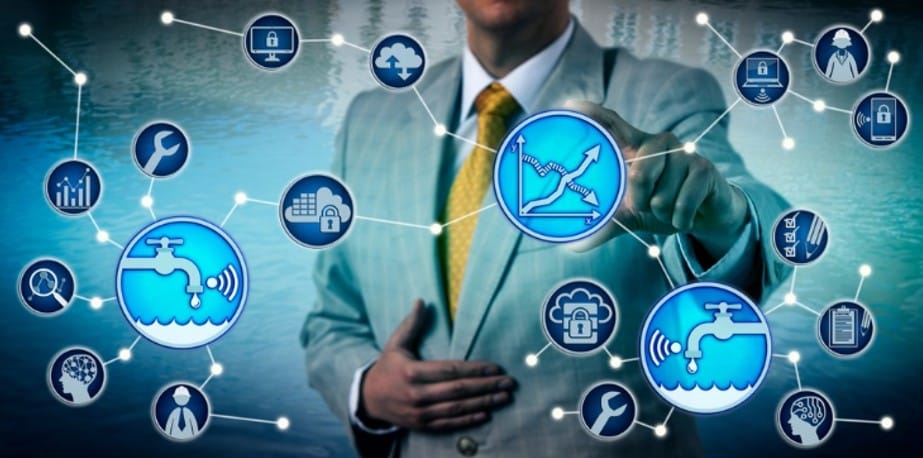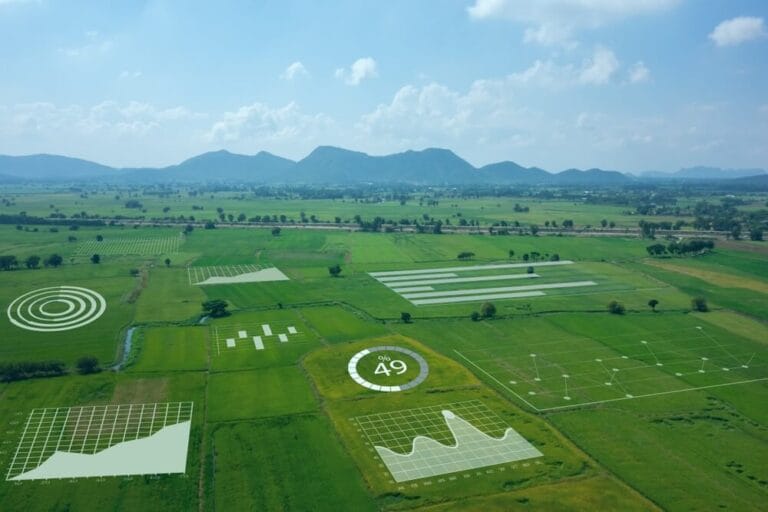Smart Water Systems – The Future of Water Management in Smart Cities
Many cities around the world are turning to newer technologies to target and solve water problems through data gathering, analysis, and automation. These technologies combine the Internet of Things (IoT), artificial intelligence (AI), hardware, software, and analytics.
Switching from conventional water management to smart water systems provides lasting solutions for cities looking to improve water delivery and management. Urban areas with old water infrastructure must start to look into ways to integrate newer technologies.
Why Smart Water Systems?
About 6 billion gallons of treated water are lost to leakages every single day in the US alone. To put this in perspective, the amount of daily non-revenue water in the United States can fill more than 9,000 swimming pools. The global volume of daily non-revenue water is estimated to be 126 billion cubic meters.
Considering this fact, municipality leaders must develop forward-thinking policies to prevent this colossal loss and ensure water security. This is one of the areas where smart meters and flow meters can save a lot of money.
However, smart water technology goes beyond remote metering and measuring flow. The technology for smart water management cuts across every aspect of the water cycle, including sourcing, treatment, supply, consumption, and reclamation.
Smart water solutions provide effective leak detection, water distribution monitoring, water quality monitoring, flood detection, and smart water metering. These functions rely on accurate, timely, and robust data, and that’s where supervisory control and data acquisition (SCADA) comes into play.
Using sensors, SCADA technology provides information at wastewater treatment plants or water distribution systems, and consumer locations. Sensors installed on networks provide real-time data about water pressure, flow rates, and water volumes. They can also monitor water quality to provide data on impurity levels. On the other hand, sensors installed at consumer locations provide data on water usage for billing purposes.
By combining cloud-based SCADA systems with AI-based software, water utilities can access more robust data to understand how systems perform during heavy rainfall, low water levels, and other abnormal situation. Analyzing historical data allow operators to establish a baseline for normal system behavior, which enables sensors and IA systems to quickly detect deviations and send out warning alerts.
Key Benefits of Upgrading to Smart Water
Switching from a conventional water system to a smart one requires a sizable investment in newer technologies. That said, cities upgrading their water systems will see lots of benefits. Major smart water benefits include:
Improved Water Quality
Sophisticated sensors installed in water treatment facilities can check for contamination. These IoT-based systems capture standard water quality monitoring parameters, like temperature, pH, and oxidation-reduction potential. With this data, the devices can monitor and adjust water treatment plans and predict water quality using AI-based software and machine learning.
By constantly monitoring impurities so that they don’t exceed permissible levels, IoT-based sensors ensure good water quality and prevent full-blown water pollution. Also, utility managers can stay on top of water quality issues to reduce service disruptions to paying consumers.
Water Flow Measurement in Real Time
With conventional water distribution systems, water flow is measured at the consumers’ meter or water reservoir. Whatever happens between the “source” and the “destination” of the distribution is unaccounted for. Installing sensors throughout distribution systems allows utilities to monitor what is happening at all times, from the distribution point to reservoirs and consumers’ meters.
Efficient Water Use
The water industry loses billions of dollars every year when the water produced is lost before reaching consumers. Undetected leakages are a major cause of non-revenue water, and in many cases, water utilities with old systems learn about leakages only when there is a need for major repairs.

With smart water technology, utilities can monitor changes in volume as they occur via water flow information alerts in real-time. This allows companies to fix leakages and other minor issues before they cause major problems that can lead to loss of revenue.
Consistent Water Pressure
With old systems, usage rates usually lead to fluctuations in water pressure at different points. Inconsistent water pressure can affect water quality as groundwater leaching may occur. Besides, fluctuations in water pressure can make it difficult for fire departments to effectively put out a fire during emergencies.

Smart water technology ensures constant water pressure is maintained at all hydrants and throughout the system, regardless of high or low usage rates. Consistent water pressure means groundwater leaching is a non-issue, and consumers and emergency services that depend on water supply can work effectively.
Proactive Maintenance
Maintenance teams need accurate and timely data for efficient maintenance and repairs. With SCADA sensors, maintenance teams receive up-to-date performance information on each piece of equipment in the distribution network.
By analyzing historical data, maintenance teams can provide more cost-effective maintenance rather than relying solely on fixed maintenance schedules that are mostly untimely and inefficient.
Early Epidemic Detection
The benefits of smart water technology aren’t limited to the water sector. IoT sensors installed in sewer systems can be helpful in epidemiology. By observing sewer system data, sensors can provide early warning of an epidemic, alerting authorities to areas where outbreaks are likely to occur.
Sewage monitoring in Italy is a typical example of how smart water systems can prevent a full-blown epidemic. Wastewater monitoring using IoT sensors showed that traces of coronavirus were already circulating in Italy before the first case of the virus was reported in China.
Continuous wastewater monitoring can help governments and public health officials to better understand infection hotspots and provide localized responses during outbreaks.
Decreased Cost and Increased Revenue
With smart technology, utilities increase the efficiency of systems and minimize leakages ― two factors that can significantly lower overall costs and boost revenue. And because smart systems are sustainable and cost-effective, water rates will not increase dramatically. This means more people will have access to portable water at reasonable rates while utilities see higher income.
Optimized Upgrades and Expansions
Smart technology eliminates guesswork when it comes to upgrading and expanding existing systems. Designers can use historical data to know how best to upgrade systems or increase capacity to improve performance in the most cost-effective way.
Smart Water Technology and Applications
The past few years have seen numerous smart city companies come up with groundbreaking innovations to make urban life easier. Thanks to this innovativeness, cities can deploy various advanced technologies for more efficient water management.

Many smart water solutions find practical use in water metering, pressure detection, and flood detection. The systems also help in water quality and stormwater management, as well as water and wastewater treatment. Technologies powering digital and smart water solutions in these key areas are generally grouped into the following four categories:
1. Digital Output Instruments
Digital output instruments collect and transmit data in real-time. Typically, these refer to sensors installed throughout distribution systems as well as water meters attached to networks.
Common applications for sensors and smart water meters include:
- Smart water meters for measuring water consumption and proper billing
- Optical sensors for water quality monitoring
- Smart flow meters for controlling water usage
- Smart rain gauges for measuring rainfall in real-time and providing cumulative rainfall total
- Video surveillance cameras for monitoring and protecting rain and floodwater systems
- Acoustic leak-sensing devices for real-time leak detection
- Water pressure monitoring devices for pump optimization and leak detection
2. SCADA Systems
SCADA technology enables remote and secure data processing, allowing the automation of systems and processes. For example, secure cloud servers can set water levels and chemical feed rates to adjust these parameters according to changing conditions.
Common areas SCADA systems are often used include the following:
- Water treatment plant control
- Pump station optimization
- Pressure management
- Reservoirs, environmental controls, and flows
- Sewage treatment plant control
3. Geographic Information System (GIS)
Municipal leaders rely on timely data for policy formulation as it concerns water security, and water utility managers need accurate information for better decision-making. GIS provides insights by allowing effective data collection, storage, management, and manipulation. The system also makes it easy to analyze spatial data.
Practical applications of GIS include:
- Asset mapping
- Asset management
- Fully integrated network models
- Environmental data analysis and management
4. Software
Besides the usual storing and reporting of data, smart water management use advanced software to improve designs, manage risks, model environmental systems and infrastructure, and make high-quality decisions.
The application of software in smart water systems takes on various forms, such as:
- Managing customer databases
- Automatic metering, billing, and collections
- Cloud-based data management
- Integrating with GIS and SCADA systems for improved infrastructure management
Cities Using Smart Water Technology
Local authorities in many cities across the world are already leveraging the vast potential of IoT, AI, and Big Data and are achieving notable success in water management. Here are a few cities integrating smart water systems into their infrastructure.
1. Kansas City, Missouri
Kansas City has the planet’s largest smart sewer sensor network ― a cost-effective system projected to save taxpayers more than $1 billion. The smart technology consists of IoT-based sensors that measure water flow and depth in the city’s wastewater system.

An AI system is trained using the data collected from the sensors to predict the sewer system’s performance during various storm conditions. The information gathered from the city’s smart technology enables optimal wastewater and stormwater conveyance, storage, and treatment throughout Kansas City.
2. Stockholm, Sweden
In 2017, Stockholm’s city officials and university researchers collaborating with Ericsson, developed and implemented a connected water quality monitoring system that continuously monitors the quality of water throughout the city in real-time.

Using a combination of sophisticated sensors, the technology alerts water utilities and companies of any changes in the water quality. In addition to rapidly detecting drop-offs in quality, the system can pinpoint the exact water quality issue (such as discharge of industrial water, algae boom, or other natural events). This eliminates the guesswork in fixing problems and allows relevant authorities to make informed decisions to avert adverse effects.
3. Ann Arbor, Michigan
The Huron River in Ann Arbor, Michigan, is the city’s primary source of drinking water. This is why the city invested in a futuristic storm drain system to protect the river and retain and reduce stormwater flow throughout the city. The smart storm drain system provides real-time information on water quality and flow via sensor nodes.
4. Cape Town, South Africa
In 2018, Cape Town was on the brink of becoming the first major city in the world to experience Day Zero; its dam levels suffered the worst water crisis in more than a century, and the city almost ran out of water.

Yet, Cape Town tackled this challenge head-on and even saved millions of dollars doing it. Currently, the city has reduced its water consumption by a whopping 30% in the past decade, although the population has grown by nearly the same margin.
Local authorities achieved this impressive feat by installing smart water meters across the city’s distribution network. The water-saving technology adjusts water pressure to suit consumption, detects leaks and alerts authorities, and significantly cuts back wastage.
5. Valencia, Spain
Valencia City Council partnered with s::can GmbH, an Austrian smart water solutions company, to deploy advanced pipe monitoring software in its water distribution network. The system accurately predicts the city’s water demands as well as fluctuations in water quality.

The system allows the council to anticipate and proffer solutions long before problems arise and fix issues with the water system as quickly as possible, ensuring less downtime and optimizing consumption.
The Future of Water Management
While building more dams, increasing storage tank capacities, and laying new pipes are great, they certainly can’t meet the water infrastructure demands of tomorrow’s cities.
Smart technologies are the future of water management, and if cities must reduce water scarcity while increasing the efficiency of water utilities, municipality leaders must seriously consider integrating smart water systems into existing and future water infrastructure.
Digital technology is crucial to better water management as it improves data collection and analytics and offers real-time insights. All this leads to proactive decisions that ensure water quality and security.
Inspired? Pin it!







